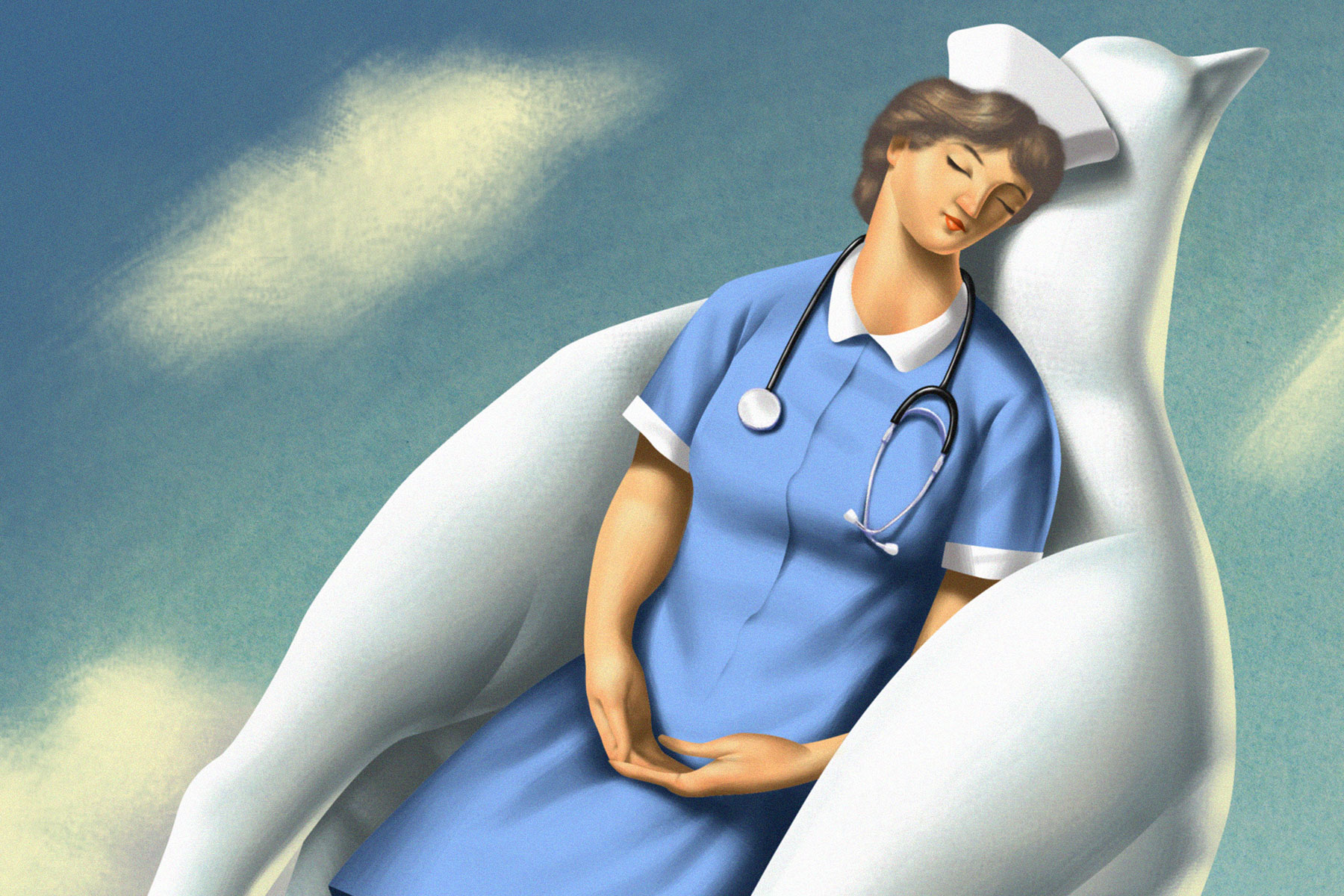Nothing that the doctor said surprised Kathleen Shuey. She knew about the likelihood of fatigue from the chemotherapy. She knew about the probable hair loss, about how her urine might turn pinkish red or nuclear orange, about how the flavors of some foods might change. She knew how susceptible she’d be to illness. She is a clinical nurse specialist who determines best practices for procedures like administering drugs. If she’d wanted to, she could have stopped her oncologist right then and there, maybe even finished her sentences.
She knew all the words, but she had never lived them. She could not have known that the fatigue would be so deep that, when sitting in her living room chair, the hallway may as well have been in another state. She couldn’t have known how it would make her feel to look down at her breasts and ponder their fate. She may have known the likelihood of having a reaction to one of the drugs, but she didn’t anticipate the rash that would spread across her neck and down to her chest, a reaction so severe that it delayed surgery. Her temperature once spiked so high that it required admission into the hospital. She found herself in a room where she’d stood hundreds of times. Lying in the bed, it suddenly seemed foreign to her.
The disease that Shuey had dedicated her life to researching and fighting had now come for her, just as it had come for her father and her aunt and her uncle. The lifelong nurse had stage two breast cancer, her doctor told her. The words that she’d mastered for her job now turned on her, each one with sharp, deadly edges.
Shuey, 59, is one of five clinical nurse specialists at Baylor University Medical Center, near downtown Dallas. Her office is on the fifth floor in a building across from the Charles A. Sammons Cancer Center, one of the most highly regarded oncology providers in the country. Her space—small and unremarkable, most surfaces covered in paperwork—belies her importance to the healthcare system, which has grown to include nearly 50 hospitals in cities as far north as McKinney and as far south as Brenham.
She works with nursing staff and clinicians alike, overseeing projects that gauge the quality of care being provided to hundreds of patients. She stays current on new research and educates her colleagues about drugs that are coming to market. She makes presentations at national conferences on behalf of Baylor and sits on the system’s institutional review board, which approves the institution’s individual studies.

For how far she has come, Shuey fell into healthcare by happenstance. Growing up in San Antonio, she was given a simple choice by her mother: teacher or nurse.
“I said nurse one too many times,” she says.
When she was in the fifth grade, her father was diagnosed with breast cancer. It’s incredibly rare. Less than 1 percent of all breast cancer cases occur in men. He died nine years later, just as she was accepted to nursing school. She recalls him waiting for a nurse to visit the family’s home, to show her mother how to administer the painkiller Demerol.
“He died at home,” she says. “We’ve improved a heck of a lot from that time. He was in tremendous pain, waiting for someone to show up and show my mom how to give him shots.”
She found herself gravitating toward oncology in her studies, writing papers on the relationship between nutrition and cancer. She signed up for the first elective course in cancer offered at the University of the Incarnate Word, in her hometown. Upon her graduation, in 1979, she landed interviews at two prominent Houston hospitals. But across the street loomed MD Anderson Cancer Center, perhaps the nation’s most renowned oncology hospital. She called and asked if they were looking for a nurse. They were.
It wasn’t ideal. It was a night gig, and it paid less than the other offers. But it gave her a chance to work directly with the disease that had fascinated her as much as it had challenged her personally.
“The manager came down from one of the units and she said, ‘Well, what type of cancer are you interested in?’ I said, ‘I’m just interested in cancer,’ ” Shuey remembers. “I—young, new, and just out of nursing school—didn’t realize there’s a breast cancer floor. There’s a lymphoma floor. There’s a melanoma floor. Each disease had its own floor.”
Her first job was working with leukemia patients and high-dose chemo treatments. She was there for the second bone marrow transplant ever performed. The patients on her floor would receive chemotherapy while under a protective bubble. She recalls playing cards with one of them. He dealt their hands from behind the barrier. She tried hard not to accidentally cheat. Shuey later moved to the lung cancer floor, where protocol books were stacked up on the floor. Back then, nurses found their own answers to questions.
She stayed in Houston for 13 years, eventually moving to a hospital in New Mexico to be closer to her sister, brother-in-law, nephew, and her newborn niece. She provided care to the large hematology population at Presbyterian Healthcare Services in Albuquerque, where she worked her way up to the hospital’s oncology program coordinator. After the kids grew up, she landed a job at US Oncology, in the Houston suburb of The Woodlands, where she provided corporate support for managing physician practices.
In 2010, when the job at Baylor opened, it combined her professional experiences. The scale was most similar to MD Anderson, the patients were like those in New Mexico, and she’d have the managerial responsibilities she’d had at US Oncology. What she didn’t anticipate was the strong support system she would wind up needing.
After her diagnosis, in 2015, Shuey decided she wouldn’t let the cancer define her. She would not introduce herself as a cancer patient. She would not even bring up her disease unless it was pertinent to the conversation she was having. She was Kathleen. She was not Cancer. She told friends and family, of course, and informed colleagues of her diagnosis only after the rumor mill started going. But her philosophy did not change.
“When I can relate to it, I’ll share it with others. But I don’t want to go in and say, ‘Hi, I have breast cancer, so I’m special,’ ” she says. “I’m me. I’m working a full schedule, doing the things that I was doing before. I just happen to have some health issues I have to follow up on.”
Kelsey Haley learned of Shuey’s cancer during her first week on the job. Haley was hired as a nurse educator for oncology across Baylor Scott & White’s North Texas hospitals. The system, the result of a merger between the Dallas-based Baylor and Temple’s Scott & White, had grown without a point person overseeing oncology education for all of the hospitals and outpatient centers. Shuey found the grant money to hire Haley. On her first week, Haley remembers, Shuey handed her an orientation packet.
“She’s telling me, ‘I put this packet together for you. Here’s what to do. Here’s how to get acclimated to the system,’ ” Haley remembers. “After she explained all that, she said, ‘I feel like I should tell you,’ and then she said she was recently diagnosed with breast cancer. I was totally taken off guard.”
Shuey continued to downplay her diagnosis. Marygrace Hernandez-Leveille, a close friend and a nurse scientist and nurse practitioner, recalls that Shuey wanted to give a presentation in New Orleans that the two had been working on, even after a biopsy had found cancer. She wanted to hold off for another few days on chemotherapy.
“I said, ‘Kathleen, your health is more important than this,’ ” she says. “I told her, ‘You have to.’ ”
I’m me. I’m working a full schedule, doing the things that I was doing before. I just happen to have some health issues I have to follow up on.
The mammogram and biopsy found the disease in January of 2015. The oncologists wanted to do chemotherapy before surgery, which surprised Shuey. But she trusted her oncologist, and, by February, a catheter was connected to a vein through a port. The toxic chemotherapy drugs flowed in immediately, the Sudafed-red epirubicin, the clear cyclophosphamide, and the fluorouracil. This regimen, known as FEC, brought a fatigue that remained for the full 14 months of treatment—through the chemo, after the surgery, onto radiation. She once drove her sister to the airport and fell asleep in her car for an hour. She’d take meetings on her phone instead of attending in person. Still, she showed up for work. She got her job done.
“I don’t ever want to feel that tired again,” she says.
Shuey, who lives alone, would come to rely on Hernandez-Leveille’s tenacity and generosity. Even if she didn’t want it. When her sister wasn’t in town, it was Hernandez-Leveille who drove Shuey to chemotherapy treatments. It was Hernandez-Leveille who badgered her to go to the hospital when her temperature jumped and her blood pressure plummeted.
“Sometimes,” she says, “you have to be willing to fight with your friend.” She’s referring to a phone call one night, when Shuey complained of the fatigue and noted that she had a fever. Hernandez-Leveille hung up the phone and got into her car. She wouldn’t accept a “no,” and by the time Shuey got to Baylor, her potassium levels were so low that she had to be admitted.
Shuey remembers how the room seemed to swallow her as she lay on the bed. She typically walked into these patient rooms confident and prepared to help or observe. Now she was the one looking up at the ceiling and feeling helpless. She remembers all the times she told the nurses not to put the bedside table too far from the patient; now, when she needed it, the table stood within her reach. When she buzzed the call light for a nurse to come, she was now the one waiting for a response from a place that she could not see. When she could finally get up to walk, she felt grateful for the nonskid socks that she’d always reminded the nurses to give to patients.
“You’re dependent,” Shuey says. “I don’t like being dependent.”
She’d have five more rounds of chemotherapy before the surgery. This time, she drank the Gatorade that she would’ve advised her patients to drink. She wasn’t admitted again.
Patients tend to think of doctors and nurses as invincible totems, impervious to the diseases they treat. They’re not, of course. And they face the same questions that all sick people wrestle with: how do you process your own diagnosis? How does it affect you as you live your life? A chronic disease is a great equalizer. When you’re healthy, you try to be there for others when they need you, maybe push them when they need you to. You offer a hand. Usually that comes back to you when you need one.
Margaret Hubbard, a nurse educator in the operating room, had been diagnosed with stage three breast cancer six months before Shuey. Their offices are down the hall from one another, but the disease brought them together. Shuey helped Hubbard understand the chemotherapy drugs; when a doctor had tried to explain them to her, Hubbard said, it sounded like the parents talking on Peanuts: “Wah. Wah-wah-wah.” Hubbard helped Shuey learn what to do after surgery. Her advice helped her avoid lymphedema, where the absence of the lymph nodes creates a fluid buildup and causes an arm or a leg to swell up like a water balloon.
Shuey helped nurse educator Theresa Ivey when her sister was given a surprising diagnosis of leukemia. Ivey recalls Shuey lining up an appointment with a specialist the night of the diagnosis. She sent over reading material that helped Ivey and her family understand what was coming. “That’s the kind of person she is when it comes to the world of oncology,” Ivey says.
When the disease came for her, Shuey didn’t want to ask for help, but she got it from her colleagues and her immediate family. She didn’t want to ask for dinner, or for a ride, or for a day off. Sometimes dinner would just show up. Other times, before a meeting, an attendee with a cough would be asked to take the meeting on the phone from his office. Shuey never knew. One of her warmest memories is the pink-out party, a surprise from her colleagues. Everyone donned pink boas and pink paper scrub tops. Shuey even pulled off her wig. Everyone giggled along with her.
“You’re so often caring for those people,” Ivey says. “But sometimes, you are those people.”
Today, Shuey has finished chemotherapy—three rounds of the FEC and three rounds of another regimen, which required many six-hour days. The surgery, a double mastectomy with the removal of lymph nodes in her right breast, was successful. She got through the radiation and started her hormone treatment. She is now disease-free. Two words that make her happy—as a nurse and a patient.
Author








